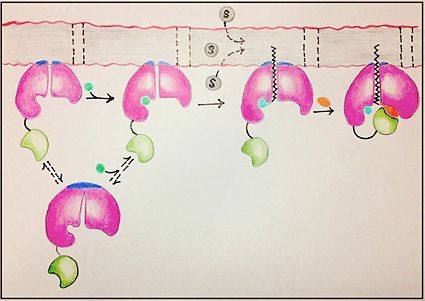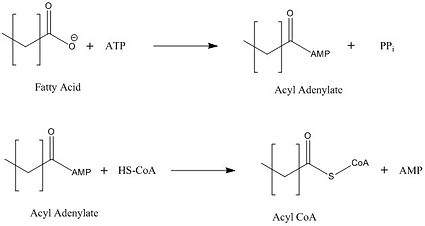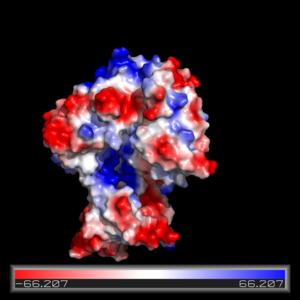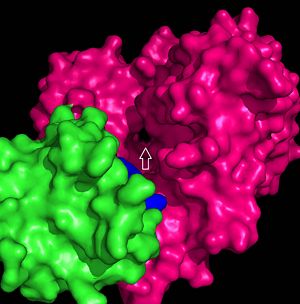Sandbox Reserved 1066
From Proteopedia
(Difference between revisions)
| Line 9: | Line 9: | ||
''Mycobacterium tuberculosis'' very-long-chain fatty acyl-CoA synthetase, also known as FadD13, is unique within its class of FadD proteins in regards to its ability to house lipid substrates longer than itself. These lipid substrates are very-long-chain fatty acids between lengths C22 –C26, which is up to the maximum length tested. <ref name="Our Paper"/> The significance of theses very-long-chain fatty acids lies in their importance to mycolic acid synthesis by ''Mycobacterium tuberculosis'' ''(M. tb)''. Mycolic acids compose part of the cell wall of ''(M. tb)''. FadD13, an activator of mycolic acids, has been identified as key component in the virulence of [https://en.wikipedia.org/wiki/Mycobacterium_tuberculosis ''Mycobacterium tuberculosis''], the etiological agent of [https://en.wikipedia.org/wiki/Tuberculosis tuberculosis], and has emerged as possible target for novel therapeutic agents.<ref name="JT">PMID: 20454815</ref> The FadD13 enzyme is the last gene of the ''mymA'' operon. <ref name="residue paper"/> | ''Mycobacterium tuberculosis'' very-long-chain fatty acyl-CoA synthetase, also known as FadD13, is unique within its class of FadD proteins in regards to its ability to house lipid substrates longer than itself. These lipid substrates are very-long-chain fatty acids between lengths C22 –C26, which is up to the maximum length tested. <ref name="Our Paper"/> The significance of theses very-long-chain fatty acids lies in their importance to mycolic acid synthesis by ''Mycobacterium tuberculosis'' ''(M. tb)''. Mycolic acids compose part of the cell wall of ''(M. tb)''. FadD13, an activator of mycolic acids, has been identified as key component in the virulence of [https://en.wikipedia.org/wiki/Mycobacterium_tuberculosis ''Mycobacterium tuberculosis''], the etiological agent of [https://en.wikipedia.org/wiki/Tuberculosis tuberculosis], and has emerged as possible target for novel therapeutic agents.<ref name="JT">PMID: 20454815</ref> The FadD13 enzyme is the last gene of the ''mymA'' operon. <ref name="residue paper"/> | ||
| - | There are four main groups of FadD enzymes | + | There are four main groups of FadD enzymes categorized on their ability to accommodate different length substrates: short (C2-C4), medium (C4-C12), long (C12-C22), and very long (C22-C26).<ref name="Our Paper"/> Most FadD class proteins exist as integral membrane proteins, involved in both the activation of fatty acids and other hydrophobic substrates in addition to the transport of these lipids into the cell. However, substrates longer than the enzyme itself, like these very-long-chain fatty acids, pose and interesting structural dilemma to the enzyme. In order for FadD13 to accommodate these very long substrates, it differs structurally in that it exists as a peripheral protein on the inside of the cell membrane. This feature is key to the mechanistic basis for FadD13’s activation and transport of fatty acids of length C24-C26 through the two step addition of [http://en.wikipedia.org/wiki/Coenzyme_A Coenzyme A](Figure 1).<ref name="Our Paper">PMID: 22560731</ref> |
Revision as of 02:33, 9 April 2015
| This Sandbox is Reserved from 02/09/2015, through 05/31/2016 for use in the course "CH462: Biochemistry 2" taught by Geoffrey C. Hoops at the Butler University. This reservation includes Sandbox Reserved 1051 through Sandbox Reserved 1080. |
To get started:
More help: Help:Editing |
Mycobacterium tuberculosis very-long-chain fatty acyl-CoA synthetase
| |||||||||||
References
- ↑ 1.0 1.1 1.2 1.3 1.4 1.5 1.6 1.7 1.8 Andersson CS, Lundgren CA, Magnusdottir A, Ge C, Wieslander A, Molina DM, Hogbom M. The Mycobacterium tuberculosis Very-Long-Chain Fatty Acyl-CoA Synthetase: Structural Basis for Housing Lipid Substrates Longer than the Enzyme. Structure. 2012 May 2. PMID:22560731 doi:10.1016/j.str.2012.03.012
- ↑ Jatana N, Jangid S, Khare G, Tyagi AK, Latha N. Molecular modeling studies of Fatty acyl-CoA synthetase (FadD13) from Mycobacterium tuberculosis--a potential target for the development of antitubercular drugs. J Mol Model. 2011 Feb;17(2):301-13. doi: 10.1007/s00894-010-0727-3. Epub 2010 May, 8. PMID:20454815 doi:http://dx.doi.org/10.1007/s00894-010-0727-3
- ↑ 3.0 3.1 3.2 3.3 3.4 3.5 Khare G, Gupta V, Gupta RK, Gupta R, Bhat R, Tyagi AK. Dissecting the role of critical residues and substrate preference of a Fatty Acyl-CoA Synthetase (FadD13) of Mycobacterium tuberculosis. PLoS One. 2009 Dec 21;4(12):e8387. doi: 10.1371/journal.pone.0008387. PMID:20027301 doi:10.1371/journal.pone.0008387
- ↑ 4.0 4.1 4.2 Jatana N, Jangid S, Khare G, Tyagi AK, Latha N. Molecular modeling studies of Fatty acyl-CoA synthetase (FadD13) from Mycobacterium tuberculosis--a potential target for the development of antitubercular drugs. J Mol Model. 2011 Feb;17(2):301-13. doi: 10.1007/s00894-010-0727-3. Epub 2010 May, 8. PMID:20454815 doi:http://dx.doi.org/10.1007/s00894-010-0727-3
External Resources
Tuberculosis Wikipedia page
Mycobacterium tuberculosis Wikipedia page
Coenzyme A Wikipedia page
Acyl CoA Wikipedia Page
Mycolic Acid Wikipedia page




